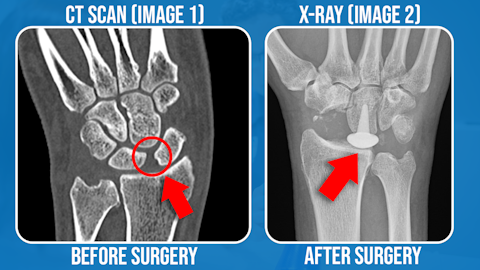
Case Study - Severe Wrist Instability
June 2020
Sometimes a seemingly minor injury can have severe long-term consequences. This fit, active gentleman in his 30s was doing a boxing fitness class about 3 years ago when he mis-hit a punching bag. He initially shrugged off his wrist pain as a simple sprain, but when it failed to improve he eventually had an MRI which showed a rupture of his scapholunate ligament. This is a tiny ligament, but a very important one for providing stability between the small carpal bones in the wrist. Surgical repair was attempted, but it ruptured again. His CT scan (Image 1) shows a wide gap between the scaphoid and lunate bones - a very characteristic sign of widespread instability through the wrist region.
Even severe damage or instability sometimes results in very little pain, but unfortunately for this gentleman, he had significant, constant wrist pain which was affecting his work and his daily life. A few weeks ago he underwent a rather dramatic operation called a 'Proximal Row Carpectomy'. As shown in his post-op X-ray (Image 2) the surgeon completely removed his Scaphoid, Lunate and Triquetrum - the 3 carpal bones nearest to the radius and ulna in the wrist joint. A pyrocarbon implant - looking like a giant thumb-tack on the X-ray - was used to provide a pivot point for wrist joint movement.
The aim of this type of surgery is to relieve some of the patient's pain while maintaining at least partial wrist joint mobility - a trade-off between stiffness and pain. If the pain levels remain too high, some patients need to sacrifice all of their wrist movement to get pain relief - a total wrist fusion. So far, though, this young man has had much less pain since his surgery, and we are hopeful of a good outcome. He is still wearing his thermoplastic wrist and thumb splint most of the time, but is starting to remove it for gentle exercises which don't flare up his pain.
